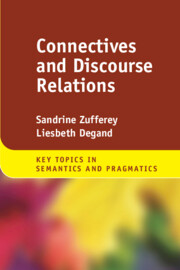Book contents
- Connectives and Discourse Relations
- Key Topics in Semantics and Pragmatics
- Connectives and Discourse Relations
- Copyright page
- Contents
- Figures
- Tables
- 1 Defining Connectives and Discourse Relations
- 2 Theoretical Models of Discourse Relations
- 3 Connectives: Meanings and Functions
- 4 Connectives between Syntax and Discourse
- 5 The Evolution of Connectives’ Meanings
- 6 Processing and Understanding Discourse Relations and Connectives
- 7 Discourse Relations and Connectives across Languages and Genres
- 8 Acquiring Connectives in a First Language
- 9 Mastering Connectives in a Second Language
- Conclusion
- Glossary
- References
- Index
- References
9 - Mastering Connectives in a Second Language
Published online by Cambridge University Press: 22 February 2024
- Connectives and Discourse Relations
- Key Topics in Semantics and Pragmatics
- Connectives and Discourse Relations
- Copyright page
- Contents
- Figures
- Tables
- 1 Defining Connectives and Discourse Relations
- 2 Theoretical Models of Discourse Relations
- 3 Connectives: Meanings and Functions
- 4 Connectives between Syntax and Discourse
- 5 The Evolution of Connectives’ Meanings
- 6 Processing and Understanding Discourse Relations and Connectives
- 7 Discourse Relations and Connectives across Languages and Genres
- 8 Acquiring Connectives in a First Language
- 9 Mastering Connectives in a Second Language
- Conclusion
- Glossary
- References
- Index
- References
Summary
In this chapter, we present an overview of current knowledge about learners’ use and understanding of connectives. In the first part of the chapter, we will see that connectives are notoriously difficult to master for second language learners, because they require an array of complex competences. Learners must know how to use them appropriately in various genres and registers, have a fine-grained understanding of the meaning differences between connectives used to convey similar coherence relations, and also automatize this knowledge so that it is activated automatically during discourse processing, and not only when they consciously elicit usage rules. In the second part of the chapter, we review the important body of studies that have empirically assessed the causes for learners’ difficulties with connectives, and conclude with some recommendations for teaching. We conclude that research on the second language acquisition of connectives contributes to answering important questions, such as what makes connectives difficult to master, and how they are they used across languages.
Keywords
- Type
- Chapter
- Information
- Connectives and Discourse Relations , pp. 188 - 208Publisher: Cambridge University PressPrint publication year: 2024

